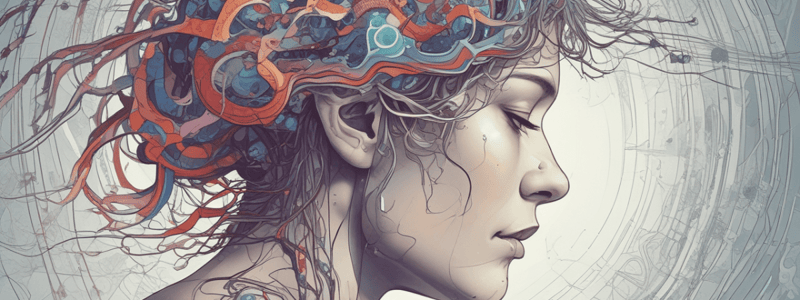Podcast
Questions and Answers
Feldman-Barrett theory claims that emotions are organized along three dimensions: pleasant-unpleasant, activation-deactivation, and reward-punishment.
Feldman-Barrett theory claims that emotions are organized along three dimensions: pleasant-unpleasant, activation-deactivation, and reward-punishment.
False (B)
The amygdala is involved in emotional memory, especially fear learning and recognizing fear.
The amygdala is involved in emotional memory, especially fear learning and recognizing fear.
True (A)
Lesions in the insula do not affect disgust perception.
Lesions in the insula do not affect disgust perception.
False (B)
The orbitofrontal cortex (OFC) computes the current value of a stimulus based on past experiences.
The orbitofrontal cortex (OFC) computes the current value of a stimulus based on past experiences.
The anterior cingulate is involved in monitoring bodily responses to emotions but not error monitoring.
The anterior cingulate is involved in monitoring bodily responses to emotions but not error monitoring.
The ventral striatum is involved in punishment-related responses.
The ventral striatum is involved in punishment-related responses.
Kluver-Bucy syndrome is characterized by increased emotional reactivity to objects.
Kluver-Bucy syndrome is characterized by increased emotional reactivity to objects.
Paul Ekman's work focused on expression, gesture, and deception, but not emotion.
Paul Ekman's work focused on expression, gesture, and deception, but not emotion.
Emotions are not associated with stimuli that are punishing.
Emotions are not associated with stimuli that are punishing.
Darwin claimed that human emotions are completely different from their animal counterparts.
Darwin claimed that human emotions are completely different from their animal counterparts.
According to the James-Lange Theory, emotions come before bodily expressions.
According to the James-Lange Theory, emotions come before bodily expressions.
The Cannon-Bard Theory states that bodily responses occur before the emotion itself.
The Cannon-Bard Theory states that bodily responses occur before the emotion itself.
The Papez Circuit is responsible for differentiating between different emotions.
The Papez Circuit is responsible for differentiating between different emotions.
The hippocampus is a primary region for emotions.
The hippocampus is a primary region for emotions.
Emotions are not critical for guiding social behavior.
Emotions are not critical for guiding social behavior.
Group living is not survivally advantageous.
Group living is not survivally advantageous.
The simulation theory is used to understand others' emotions and actions by directly asking them.
The simulation theory is used to understand others' emotions and actions by directly asking them.
Facial identity is primarily processed in the superior temporal sulcus.
Facial identity is primarily processed in the superior temporal sulcus.
The theory-of-mind is the ability to appreciate others' points of view and share their experiences.
The theory-of-mind is the ability to appreciate others' points of view and share their experiences.
Eye gaze information is only important for group communication.
Eye gaze information is only important for group communication.
The mirror system is a neural circuit that only processes self-related information.
The mirror system is a neural circuit that only processes self-related information.
Patients with Capgras syndrome are unable to recognize the person they are looking at.
Patients with Capgras syndrome are unable to recognize the person they are looking at.
Emotions are not involved in guiding social behavior.
Emotions are not involved in guiding social behavior.
The James-Lange Theory states that emotions come before bodily expressions.
The James-Lange Theory states that emotions come before bodily expressions.
Darwin claimed that human emotions are unique and unrelated to their animal counterparts.
Darwin claimed that human emotions are unique and unrelated to their animal counterparts.
The Papez Circuit is responsible for differentiating between different emotions.
The Papez Circuit is responsible for differentiating between different emotions.
Group living is not survivally advantageous.
Group living is not survivally advantageous.
Emotions are only associated with stimuli that are rewarding.
Emotions are only associated with stimuli that are rewarding.
The Cannon-Bard Theory states that bodily responses occur before the emotion itself.
The Cannon-Bard Theory states that bodily responses occur before the emotion itself.
Paul Ekman's work focused on emotions, not expression, gesture, and deception.
Paul Ekman's work focused on emotions, not expression, gesture, and deception.
The Feldman-Barrett theory claims that emotions are organized along two dimensions: pleasant-unpleasant and activation-deactivation.
The Feldman-Barrett theory claims that emotions are organized along two dimensions: pleasant-unpleasant and activation-deactivation.
The amygdala is primarily involved in memory, especially non-emotional content of memories.
The amygdala is primarily involved in memory, especially non-emotional content of memories.
Lesions in the insula affect disgust perception more than recognition of other facial expressions.
Lesions in the insula affect disgust perception more than recognition of other facial expressions.
The orbitofrontal cortex (OFC) computes the current value of a stimulus based on past experiences and personal preferences.
The orbitofrontal cortex (OFC) computes the current value of a stimulus based on past experiences and personal preferences.
The anterior cingulate is involved in error monitoring and social aspects of emotions.
The anterior cingulate is involved in error monitoring and social aspects of emotions.
The ventral striatum is involved in reward-related responses.
The ventral striatum is involved in reward-related responses.
Kluver-Bucy syndrome is characterized by unusual tameness and emotional blunting.
Kluver-Bucy syndrome is characterized by unusual tameness and emotional blunting.
Paul Ekman's work focused on expression, gesture, deception, and emotion.
Paul Ekman's work focused on expression, gesture, deception, and emotion.
The fusiform face area is primarily involved in expression recognition and gaze processing.
The fusiform face area is primarily involved in expression recognition and gaze processing.
Social referencing involves the emotional response of another person leading to a neutral response to a previously neutral stimulus.
Social referencing involves the emotional response of another person leading to a neutral response to a previously neutral stimulus.
Eyes are only important for group communication.
Eyes are only important for group communication.
Empathy is the ability to represent the mental states of others.
Empathy is the ability to represent the mental states of others.
The mirror system is only involved in understanding others' emotions and actions.
The mirror system is only involved in understanding others' emotions and actions.
Patients with Capgras syndrome are unable to recognize the person's emotions.
Patients with Capgras syndrome are unable to recognize the person's emotions.
Flashcards are hidden until you start studying
Study Notes
Emotions
- Emotions are states associated with stimuli that are rewarding or punishing, guiding us on how to behave and what to avoid or seek out.
- Emotions are critical for guiding social behavior, allowing us to mentalize (infer) and mirror (share) others' emotions and mental states.
Theories of Emotion
- Darwin's theory: Human emotions possess continuity with their animal counterparts, with conserved expressions across species.
- James-Lange Theory: Emotion comes after expression, with self-perception of bodily changes producing emotional experience.
- Cannon-Bard Theory: Emotions come before expression, with bodily responses occurring after the emotion itself.
- Papez Circuit and Limbic Brain: The papez circuit involves the cingulate cortex, hippocampus, hypothalamus, and anterior nucleus of the thalamus, while the limbic brain includes the amygdala and orbitofrontal cortex.
Paul Ekman's Basic Emotions
- Dr. Paul Ekman's work on expression and gesture and their role in emotion and deception.
Other Contemporary Approaches
- Feldman-Barrett theory: All emotions tap into a core affect system organized along two dimensions: pleasant-unpleasant and activation-deactivation.
- Rolls theory: A constructionist approach, concerned with the dimensions of reward and punishment, their presence/absence, and intensity.
Neural Substrates
- Amygdala: Involved in memory, especially emotional content of memories; important for fear learning and recognizing fear.
- Insula: Involved in bodily perception, pain and taste perception, and disgust (including moral disgust); monitors the internal state of the body.
- OFC (Orbitofrontal Cortex): Computes the current value of a stimulus, linked to subjective reports of pleasantness.
- Anterior Cingulate: Involved in error monitoring, bodily responses to emotions, and pain, as well as social aspects like empathy and exclusion.
- Ventral Striatum: Dopaminergic pathway involved in reward-related processes, including social rewards.
Reading Faces
- Facial identity: Fusiform face area
- Expression recognition & gaze processing: Superior temporal sulcus
- Expressions also involve the extended system: Amygdala & insula
- Simulation theory: We understand others' emotions and mental states by vicariously producing their current state in ourselves.
Reading Faces (continued)
- Social referencing: The emotional response of another person can lead to avoidance or interaction with a previously neutral stimulus.
- Capgras syndrome: Patients can consciously recognize the person, but lack an emotional response to them, believing they were replaced with body doubles.
Eye Gaze Information
- Eyes inform about emotions, important for one-to-one communication.
- Eye gaze can infer desire (next move).
Reading Minds
- Theory-of-mind: The ability to represent the mental states of others (e.g., beliefs, desires, intentions).
- Empathy: The ability to appreciate others' points of view and share their experiences.
- Mirror system: Neural circuits or regions that disregard the distinction between self and other.
Emotions
- Emotions are states associated with stimuli that are rewarding or punishing, guiding us on how to behave and what to avoid or seek out.
- Emotions are critical for guiding social behavior, allowing us to mentalize (infer) and mirror (share) others' emotions and mental states.
Theories of Emotion
- Darwin's theory: Human emotions possess continuity with their animal counterparts, with conserved expressions across species.
- James-Lange Theory: Emotion comes after expression, with self-perception of bodily changes producing emotional experience.
- Cannon-Bard Theory: Emotions come before expression, with bodily responses occurring after the emotion itself.
- Papez Circuit and Limbic Brain: The papez circuit involves the cingulate cortex, hippocampus, hypothalamus, and anterior nucleus of the thalamus, while the limbic brain includes the amygdala and orbitofrontal cortex.
Paul Ekman's Basic Emotions
- Dr. Paul Ekman's work on expression and gesture and their role in emotion and deception.
Other Contemporary Approaches
- Feldman-Barrett theory: All emotions tap into a core affect system organized along two dimensions: pleasant-unpleasant and activation-deactivation.
- Rolls theory: A constructionist approach, concerned with the dimensions of reward and punishment, their presence/absence, and intensity.
Neural Substrates
- Amygdala: Involved in memory, especially emotional content of memories; important for fear learning and recognizing fear.
- Insula: Involved in bodily perception, pain and taste perception, and disgust (including moral disgust); monitors the internal state of the body.
- OFC (Orbitofrontal Cortex): Computes the current value of a stimulus, linked to subjective reports of pleasantness.
- Anterior Cingulate: Involved in error monitoring, bodily responses to emotions, and pain, as well as social aspects like empathy and exclusion.
- Ventral Striatum: Dopaminergic pathway involved in reward-related processes, including social rewards.
Reading Faces
- Facial identity: Fusiform face area
- Expression recognition & gaze processing: Superior temporal sulcus
- Expressions also involve the extended system: Amygdala & insula
- Simulation theory: We understand others' emotions and mental states by vicariously producing their current state in ourselves.
Reading Faces (continued)
- Social referencing: The emotional response of another person can lead to avoidance or interaction with a previously neutral stimulus.
- Capgras syndrome: Patients can consciously recognize the person, but lack an emotional response to them, believing they were replaced with body doubles.
Eye Gaze Information
- Eyes inform about emotions, important for one-to-one communication.
- Eye gaze can infer desire (next move).
Reading Minds
- Theory-of-mind: The ability to represent the mental states of others (e.g., beliefs, desires, intentions).
- Empathy: The ability to appreciate others' points of view and share their experiences.
- Mirror system: Neural circuits or regions that disregard the distinction between self and other.
Studying That Suits You
Use AI to generate personalized quizzes and flashcards to suit your learning preferences.





